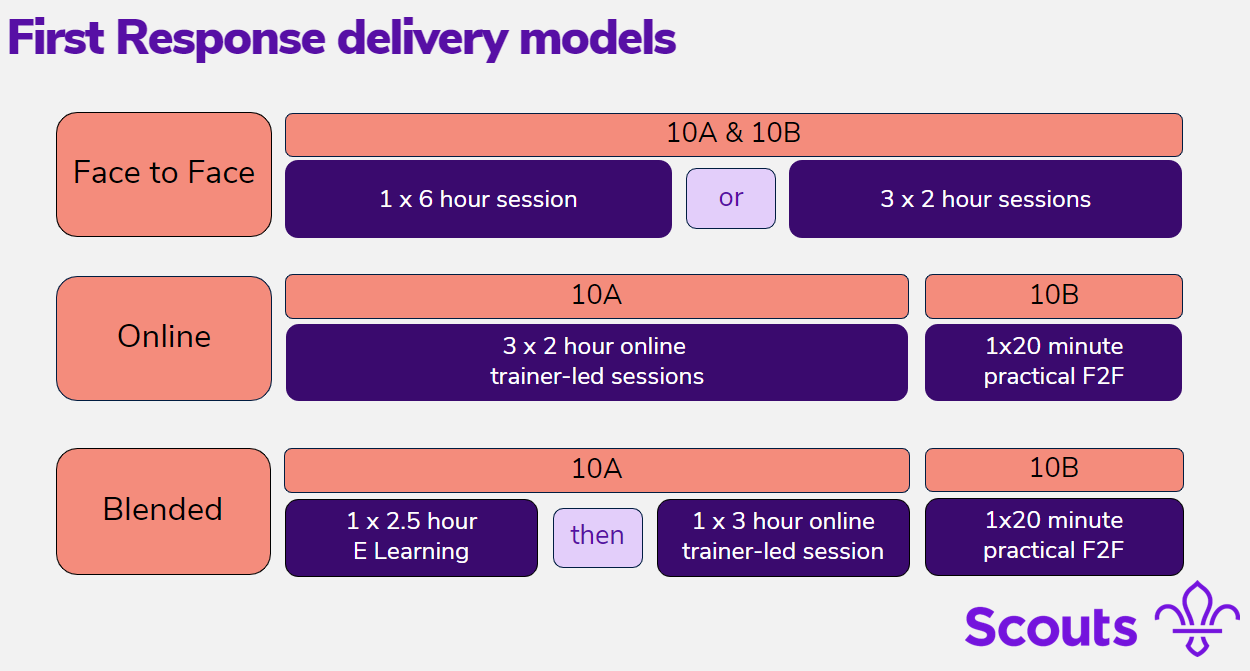First Aid
The first response course covers the skills and knowledge necessary to enable adults to manage an incident and provide basic first aid
First aid training
Doing things safely is fundamental to everything we do in Scouts, and completing the first aid training - also known as First Response course - is a key part in that.
This course aims to cover the skills and knowledge necessary to enable volunteers to manage an incident and provide basic first aid. Our first response programme has been developed in collaboration with Girlguiding, with a common syllabus, resources and acceptance between the two organisations.
Who should complete this training
You can find out if you're required to complete the first aid training by checking POR Chapter 16: Roles Table.
If this training is required for your role, you are asked complete it in within your first three years of volunteering, and to renew it every three years.
How to complete it
First aid training can be completed face-to-face and online. There are three delivery options available, and in all of them you'll be required to attend a face-to-face practical validation session.
You should check the delivery options available at your County/Area/Region (Scotland), and choose the one that suits you best.
Below you have more information about each delivery option.

Face-to-face first aid training is often done at local Scout meeting places. It contains both theory and practical parts, and can be delivered in one single six-hour session or three separate two-hour sessions.
In this delivery method, the theory part of the training (10A) is done in three separate two-hour online sessions, and the practical validation (10B) in a short (15-20min) face-to-face session, which covers the practical elements of the life support training.
The online sessions are live video calls facilitated by a first aid trainer with theory explanations, knowledge checking exercises and discussions.
Volunteers can only attend the practical validation once the theory part is completed.
The Blended Model combines a 2.5 hour eLearning with a three-hour online session for the theory part of the training (10A). The practical validation (10B) is a short (15-20min) face-to-face session, which covers the practical elements of the life support training.
The eLearning should be completed first. The online session is a live video call facilitated by a first aid trainer, with some more detailed knowledge checking exercises and discussions.
Volunteers can only attend the practical validation once the theory part (both eLearning and online session) is completed.
Note: members can access the blended model regardless of the County having signed up and will be linked up to an online session, practical validation will still need to be accessed locally once other elements are complete.
How to book first aid training
First aid training is offered locally by your County/Area/Region (Scotland). To book your training, check your local provision.
Some Counties/Areas/Regions (Scotland) might not offer all three delivery options.
What are the training objectives
By doing this training you will:
- Learn about simple first aid information which is relevant to your role
- Build confidence and skills in coping with emergency and first aid situations
- Know how to manage these emergencies
What's the content
The first aid training - also known as First Response course - focuses on three main areas:
- Life support: The principles of first aid and initial response, emergency life support, CPR, choking, and causes and treatment of unresponsiveness.
- Trauma and injury: Shock, bleeding, fractures and sprains, head injuries, dental incidents, and burns.
- Major illnesses: Asthma, anaphylaxis, heart attack, stroke, seizures, diabetes, sepsis and meningitis.
Additional information about this training
The minimum first aid required for leaders, managers and supporters is First Response (6 hours), but higher levels of qualification are needed if leading certain kinds of activities in remote environments or delivering first aid training.
You do not need to be first aid trained before you become a leader. You'll develop a personal learning plan with your training adviser and this will identify when it is best for you to undertake first aid training.
Please read our guidance on using external first aid qualifications in Scouts for more information.
The First Response Certificate provided after completing this training is designed specifically for adults in The Scouts and Girlguiding, based on the situations and issues that occur within these organisations. It is not, therefore, externally recognised.
There is no badge available for the completion of the First Response course (6 hours) for volunteers.
Volunteers with an in date first aid qualification (16 hours course, also known as full first aid course) can wear a first aider badge on the left sleeve, as shown on the uniform diagram. This can either be the badge provided by the first aid training provider or the Scouts first aider badge available from Scout Store. Only one badge may be worn.
Purple card
The Purple card provides support for safe Scouting and guidance in the procedures for dealing with an emergency.
Discover Purple cardFirst Aid Kits
Guidance for the use of first aid kits for section meetings and nights away.
Discover guidance for first aid kitsFull First Aid certificate
This qualification is relevant for those that are undertaking activities for which POR or the activity risk assessment specifies a level of expertise greater than First Response.
The Full First Aid certificate requires volunteers to hold a first aid qualification provided by a regulated body, certifying their attendance of a minimum 16 hours first aid course.